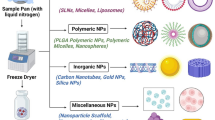Abstract
Formulation often has a dramatic effect on degradation of proteins during the freeze-drying process as well as impacting on the “shelf-life” stability of the freeze-dried product. This research presents the results of a formulation optimization study of the “in-process” and shelf-life stability of freeze-dried human growth hormone (hGH). Chemical decomposition via methionine oxidation and deamidation of asparagine residues as well as irreversible aggregation were characterized by HPLC assay methodology. In-process degradation and stability of low moisture freeze-dried solids were studied at 25 and 40°C in a nominal nitrogen headspace (≈0.5% O2). Formulation variables included pH, level of salts, and the nature of the lyoprotectant. Studies of the effect of shear on aggregation in solutions indicated that shear comparable to that experienced during filtration does not induce aggregation. Irreversible changes in hGH during the freeze-drying process were minimal, but chemical decomposition via methionine oxidation and asparagine deamidation and aggregation did occur on storage of the freeze-dried solid. Decomposition via methionine oxidation was significant. A combination of mannitol and glycine, where the glycine remains amorphous, provided the greatest protection against decomposition and aggregation. It is postulated that an excipient system that remains at least partially amorphous is necessary for stabilization. However, the observation that dextran 40 formulations showed poor stability toward aggregation demonstrates that an amorphous excipient system is not a sufficient condition for stability. Stability of the solid was optimal when produced from solutions in the pH range, 7–7.5, with severe aggregation being observed at high pH. The level of sodium phosphate buffer affected stability of the solid, although this relationship was complex. Freeze-drying in the presence of NaCl produced severe aggregation and precipitation during the freeze-drying process as well as acceleration of oxidation and/or deamidation.
Similar content being viewed by others
REFERENCES
J. Geigert. Overview of the stability and handling of recombinant protein drugs. J. Parenter. Sci. Tech. 43:220–224 (1989).
K. Hellman, D. S. Miller, and K. A. Cammack. The effect of freeze-drying on the quaternary structure of L-asparaginase from Erwinia carotovora. Biochim. Biophys. Acta 749:133–142 (1983).
P. Labrude and C. Vigneron. Stability and functional properties of haemoglobin freeze-dried in the presence of four protective substances after prolonged storage: Dose-effect relationships. J. Pharm. Pharmacol. 35:23–27 (1982).
J. F. Carpenter, L. M. Crowe, and J. H. Crowe. Stabilization of phosphofructokinase with sugars during freeze-drying: Characterization of enhanced protection in the presence of divalent cations. Biochim. Biophys. Acta 923:109–115 (1987).
M. W. Townsend and P. P. DeLuca. Use of lyoprotectants in the freeze-drying of a model protein, ribonuclease A. J. Parenter. Sci. Tech. 42:190–199 (1988).
T. I. Pristoupil, M. Kramlova, H. Fortova, and S. Ulrych. Haemoglobin lyophilized with sucrose: The effect of residual moisture on storage. Haematologia 18:45–52 (1985).
M. J. Hageman. The role of moisture in protein stability. Drug Dev. Ind. Pharm. 14:2047–2070 (1988).
F. Franks. Freeze drying: from empiricism to predictability. Cryo-Letters 11:93–110 (1990).
T. I. Pristoupil, S. Ulrych, and M. Kramlova. Haemoglobin stabilization during lyophilization with saccharides. Perturbation effect of polyethylene glycols. Coll. Czech. Chem. Commun. 46:1856–1859 (1981).
J. F. Carpenter and J. H. Crowe. Fundamental differences in the interactions of stabilizing solutes with proteins during freeze-thawing versus during freeze-drying. Cryobiology 25:537–538 (1988).
D. S. Johnson and F. Castelli. The influence of sugars on the properties of freeze dried lysozyme and hemoglobin. Thermochim. Acta 144:195–208 (1989).
G. W. Becker, P. M. Tackitt, W. W. Bromer, D. S. Lefeber, and R. M. Riggin. Isolation and characterization of a sulfoxide and a desamido derivative of biosynthetic human growth hormone. Biotechnol. Appl. Biochem. 10:326–337 (1988).
G. W. Becker, R. R. Bowsher, W. C. MacKellar, M. L. Poor, P. M. Tackitt, and R. M. Riggin. Chemical, physical, and biological characterization of a dimeric form of biosynthetic human growth hormone. Biotechnol. Appl. Biochem. 9:478–487 (1987).
M. J. Pikal, K. Dellerman, and M. L. Roy. Effects of moisture and oxygen on the stability of freeze-dried formulations of human growth hormone. Biologicals (in press).
R. M. Riggin, G. K. Dorulla, and D. J. Miner. A reversed-phase high-performance liquid chromatographic method for characterization of biosynthetic human growth hormone. Anal. Biochem. 167:199–209 (1987).
R. M. Riggin, C. J. Shaar, G. K. Dorulla, D. S. Lefeber, and D. J. Miner. High-performance size-exclusion chromatographic determination of the potency of biosynthetic human growth hormone products. J. Chromatogr. 435:307–318 (1988).
M. J. Pikal, S. Shah, D. Senior, and J. E. Lang. Physical chemistry of freeze-drying: Measurement of sublimation rates for frozen aqueous solutions by a microbalance technique. J. Pharm. Sci. 72:635–650 (1983).
C. A. Angell, E. J. Sare, and R. D. Bressel. Concentrated electrolyte solution transport theory: Directly measured glass temperatures and vitreous ice. J. Phys. Chem. 71:2759–2761 (1967).
H. Levine and L. Slade. Principles of “crystallization” technology from structure/property relationships of carbohydrate/water systems—a review. Cryo-Letters 9:21–63 (1988).
M. J. Pikal. Freeze-drying of proteins. II. Formulation selection. Biopharm. 3:26–30 (1990).
S. Charm and B. Wong. Enzyme inactivation with shearing. Biotechnol. Bioeng. 12:1103–1109 (1970).
M. Hagenlocher and R. Pearlman. Use of a substituted cyclodextrin for stabilization of solutions of recombinant human growth hormone. Abstract BT219, 4th Annual meeting of the AAPS, Atlanta, Oct. 22–26, 1989.
D. N. Brems, S. M. Plaisted, H. A. Havel, and C. C. Tomich. Stabilization of an associated folding intermediate of bovine growth hormone by site-directed mutagenesis. Proc. Natl. Acad. Sci. USA 85:3367–3371 (1988).
R. Pearlman and T. H. Nguyen. Formulation strategies for recombinant proteins: human growth hormone and tissue plasminogen activator. In D. Marshak and D. Liu (eds.), Therapeutic Peptides and Proteins: Formulations, Delivery, and Targeting, Current Communications in Molecular Biology, Cold Spring Harbor Laboratory, Cold Spring Harbor, N.Y., 1989, pp. 23–30.
T. J. Ahern and A. M. Klibanov. The mechanism of irreversible enzyme inactivation at 100°C. Science 228:1280–1284 (1985).
Author information
Authors and Affiliations
Rights and permissions
About this article
Cite this article
Pikal, M.J., Dellerman, K.M., Roy, M.L. et al. The Effects of Formulation Variables on the Stability of Freeze-Dried Human Growth Hormone. Pharm Res 8, 427–436 (1991). https://doi.org/10.1023/A:1015834724528
Issue Date:
DOI: https://doi.org/10.1023/A:1015834724528




